Peace at last!
This week we have been reading ‘ Peace at last‘ by Jill Murphy
We have been talking about all the different noises Daddy Bear could hear whilst he was trying to get to sleep! Some of those being animals outside, Can you remember what kind of animals are awake at night time?
That’s right.. Nocturnal!
One of our favourite nocturnal animals has been the Hedgehog. Sometimes we see them around school, especially in our forest area. We must remember to be quiet as they are sleeping.. Shhhh!
This week we were scientist, we made some delicious hedgehog bread. We talked about the ingredients we needed and how to use the weighing scales to measure how much we would need. Once we mixed our dough, we had to give it a good knead- this is a fantastic fine motor skill to help strengthen your child’s hand’s. We made sure our key ingredient was in.. Yeast. Without the yeast the dough wouldn’t rise. The children observed the process of the dough rising before we put them in the oven.
Here is our end result!

Help at home: Have a go at making some bread at home, What animal could you do this time? below is the recipe we used to make our bread
- 400g of wholemeal bread flour
- 1 sachet of yeast
- 380ml of luke warm water
- 2 tbsp of vegetable oil
- 1 tbsp of salt
Mix all the ingredients together and then knead for 10 minutes.
Shape your dough and add in any extras such as raisins for eyes.
Allow ro rise for 1 hour in a warm place.
Place your dough into the oven at 180 for 15 mins, (make sure your grown-up helps with this part)
Allow to cool and enjoy!
Notice:
Reminder of Parent Consultations this coming Monday 25 November 3:30-5:30pm
We’re going to the Moon!
Some of the children may have come out to you on Friday saying they need to bring snacks and a teddy as we’re going to the moon. This is partly true apart from we will be providing the snacks! So please just bring one of your teddies to school with you next week. I’ve got mine ready, he can’t wait to go!
Have a lovely weekend
The Nursery Team
Living and learning – online safety
As a class, we reflected on what we could do if we were presented with a search result that was not appropriate, we received a pop-up advert/message or received an unkind/inappropriate message when we were playing on an online game. The children had lots of ideas which they were keen to share with each other.
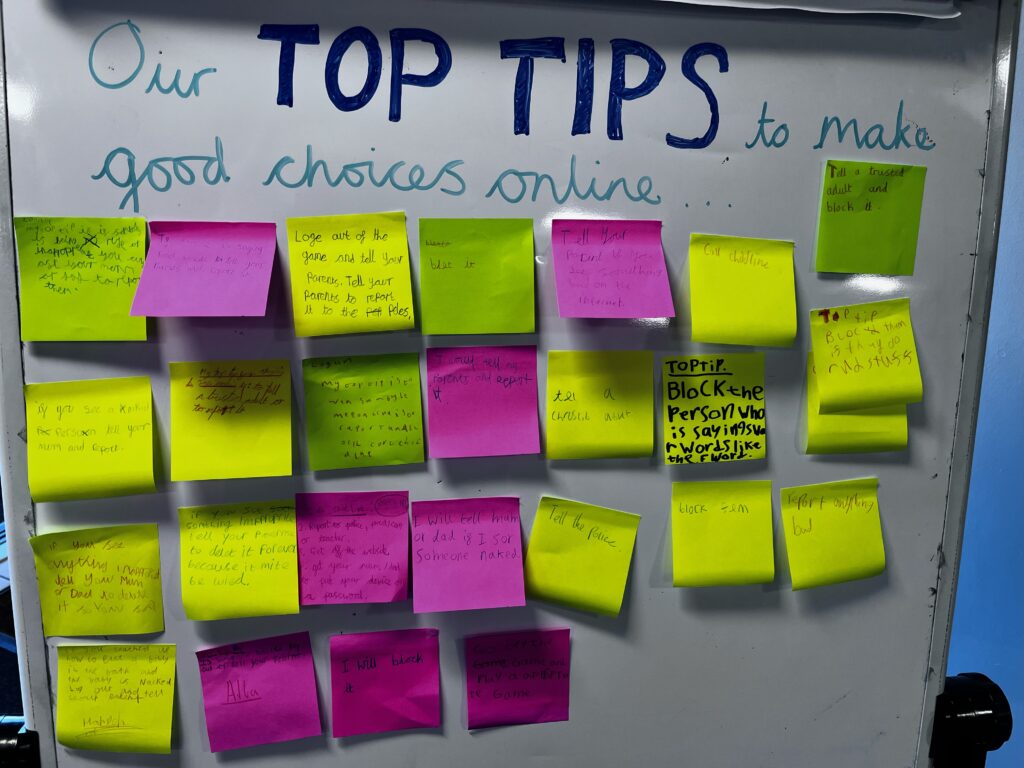
The 3 most popular tips were:
- tell a trusted adult
- close it
- block them
Help at home: If you are keen to learn more about how to keep children safe online, take a look at the advice provided by the NSPCC: NSPCC safe online
Pointillism in Year 1
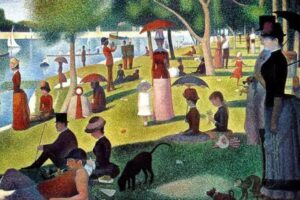
This term, Year 1 have been diving into the wonderful world of George Seurat and pointillism! Last week, we explored Seurat’s paintings, noticing how he used tiny dots to create beautiful scenes. The children were fascinated by how these little dots come together to form a bigger picture.
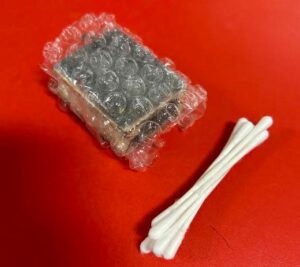
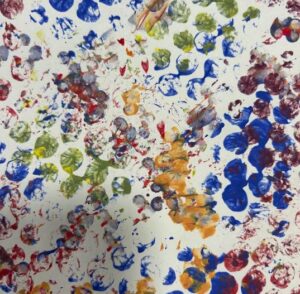
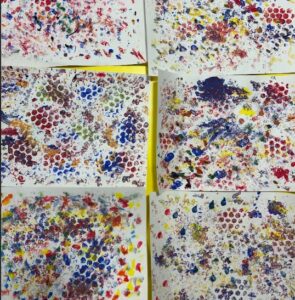
This week, they became pointillist artists themselves! Using bubble wrap and Q-tips, they experimented with primary colours (red, blue, and yellow), dabbing dots of paint to create textured masterpieces. They also explored colour mixing, discovering new shades and tones as the dots overlapped.
Help at home:
- Encourage your child to create dot art using cotton buds or paint brushes.
- Look at nature – leaves, flowers, or clouds – and discuss how tiny details create a whole picture.
PE – Gymnastics
This half term, our focus in PE is gymnastics.
We’ve been exploring movement – the different ways in which we can control our bodies and travel from one point to another. We’ve considered the height of our position and how it can change.
The children created and performed sequences, giving feedback to each other. I was astounded by the flexibility, balance and creativity on display!
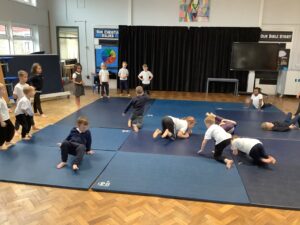
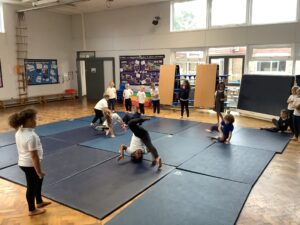
Help at home by discussing movement with your child. How can we move in different ways? Perhaps you could explore the movements of some animals – how do they move their bodies differently to ours?
Maths Stay and Learn
For those parents who could not attend the Maths Stay and Learn last week or if you would like to access the teacher presentation, please click the link below:
Parent copy SE Maths Mastery presentation stay and learn 2024
Science: Materials
This term, our Science topic is Materials. Today, we explored a variety of rocks, observing and describing their texture, colour, size, and shape. We also considered how different types of rocks might be used in real-life.
Here are some of the ideas we discussed:
- “We could use this rock to build a house or a wall.”
- “This one could be used to make a table or a bench.”
- “This type of rock would be great for carving a statue.”
- “Some rocks are perfect for kitchen worktops because they’re hard and strong.”
We compared the rocks, noting their similarities and differences. For example:
- Some rocks were smooth, while others were rough.
- Certain rocks were heavier, and some were much lighter.
Finally, we sorted the rocks based on their size and then texture, arranging them from rough to smooth. It was fascinating to see how varied and versatile these natural materials can be!






Help at home: Go on a materials hunt at home! Look around and see if you can find objects made from different materials e.g wood, plastic, rock, or metal. Use the key vocabulary below to help you describe the items you discover. What textures, colours and uses can you identify? Happy exploring!

Science – Does the temperature of water affect the time it takes for ice to melt in it?
In our chemistry unit of learning, we are learning about states of matter.
We have created gestures to help us remember our key vocabulary of solid, liquid and gas. Now that we can confidently identify and describe these states of matter, we are considering how materials can change states.
Today we planned an experiment to answer the question:
Does the temperature of the water affect the time it takes for ice to melt in it?
We had to consider the variables in the experiment including which ones would change and which ones we would keep the same to answer our enquiry. We also had to practise some key skills including measuring accurately, reading a thermometer and measuring time using a stopwatch.

We recorded our results and came to the conclusion that “The colder the water the more time it takes for ice to melt.”

Maths – column addition
In maths we have been practising adding two 4 digit numbers when an exchange is required. We started by understanding the structure of the maths by using base 10 and then place value counters to represent the maths but we are now all working in the abstract using just digits.
Across school, we all set our column addition out in the same way with the exchange underneath the sum. We also cross out the exchange when we have added it (see example below).

We use stem sentences to help us think about the procedure we are undertaking.

The instructions we have written (and follow) as a class are below. We have them on our working wall to refer to if we get stuck.

Help at home: Challenge your child to teach you how we add two 4 digit numbers using the instructions above.
Science
We are really enjoying our science lessons in Year 5 and 6. This term we are studying electricity. Today we tested whether the number of bulbs effected the brightness. The children worked well independently and in groups whilst always maintaining that they worked safely.
Help at home – Ask your child about their findings. Did adding more bulbs effects the brightness. How did they keep themselves safe? How did they maintain a fair test? What did they enjoy about today’s lesson?




Hockey at Wetherby High School
Our Year 5 children attended at hockey event last Thursday at Wetherby High School.
They took part in an array of activities and were able to demonstrate their fantastic skills and understanding from recent PE lessons. It was mentioned on multiple occasions how well behaved our children were and how talented they are too. Mrs Senior and I were so proud of the children and it is clear that we have some future hockey stars in our class!







